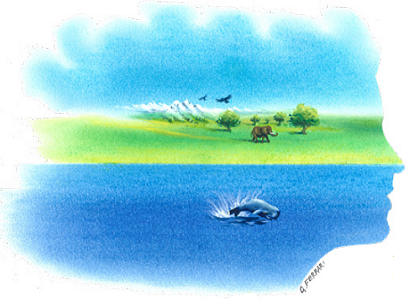Life is fun
Publish date 10-10-2023
 New discoveries and knowledge help us better understand concepts that straddle humanistic and scientific cultures. We have long thought that our vital organs remain the same throughout our lives and that only our nails, hair and skin transform. Instead, molecules in cells, tissues and organs are regenerated and replaced at different times: from a few days to years. The cells of the stomach lining every 5 days, many cells of the intestine every 20 days, of the liver every 300 to 500 days, the skeleton is replaced every 10 years. Only some of the cells present at birth remain until death (those of the central nervous system, the lens, and tooth enamel). When we move down from the cells to the atoms that make up our body (7 octillion atoms), the turnover is even faster. We drink and eat, expel and absorb... Within a year, more than 90% of the atoms present in our body are replaced by other atoms taken from the Earth's biosphere.
New discoveries and knowledge help us better understand concepts that straddle humanistic and scientific cultures. We have long thought that our vital organs remain the same throughout our lives and that only our nails, hair and skin transform. Instead, molecules in cells, tissues and organs are regenerated and replaced at different times: from a few days to years. The cells of the stomach lining every 5 days, many cells of the intestine every 20 days, of the liver every 300 to 500 days, the skeleton is replaced every 10 years. Only some of the cells present at birth remain until death (those of the central nervous system, the lens, and tooth enamel). When we move down from the cells to the atoms that make up our body (7 octillion atoms), the turnover is even faster. We drink and eat, expel and absorb... Within a year, more than 90% of the atoms present in our body are replaced by other atoms taken from the Earth's biosphere.
And then every living species is mainly made up of water coming from the hydrosphere. In the adult human body about 60%, but some parts even more: e.g. heart 73%, lungs 83%, skin 64%, muscles and kidneys 79%, blood (plasma) up to 90%. What about bacteria, the smallest life form on the planet? They are present in our body: they live in the colon, in the saliva, in the oral mucosa, in the skin. Today we know that they are not our enemies (at least not all of them), but that they play important roles within us, such as helping digestion and providing vitamins.
Today this new knowledge is changing the way we treat and promote health, increasingly personalizing care and treatments based on the inhabitants we host. The internal clocks of the human body are continuously adjusted not only with respect to what our genes already indicate and command. They also continuously adjust with respect to the impulses they receive from the cycles of the Earth's functioning, the external environment, such as the cycle of light and dark, heat and cold, rotation and electromagnetic fields. It applies to us, it applies to all other living beings. Humanity cannot be separated from nature.
Here the problem arises: we humans operate more and more in the original infrastructures of our planet (hydrosphere, lithosphere, atmosphere, biosphere), causing serious long-term damage to obtain short-term economic advantages. We must transform the way we conceive our relationships with nature, precisely through awareness of the interconnectivity of nature. From this awareness, individual and collective restorative solutions can then spread. Today we are finally becoming aware that nature's basic capital is soil. Are you sure you know that the factory of life is our soil/humus? Without fertile soil there is no vegetation and therefore photosynthesis, the basis of the food chain. The soil is a complex microenvironment, where worms, other animals, and above all microorganisms, work incessantly to decompose leftovers and waste, breaking them down into basic components and enriching the soil in the fertile thickness. Furthermore, the soil, especially in some of its forms, is a carbon sink, just like the oceans, just like tropical forests, which capture CO2 and store it. From the 1990s to today, forests are absorbing about 1/3 less CO2, due to increased temperatures, deforestation and drought. The soil retains 2,300 billion tonnes of carbon compared to approximately 790 billion tonnes contained in the atmosphere. We need to take more into consideration the soil and its use, especially if it is destroyed and desertified. We must be more careful, not only because the main source of our food (95% comes from the soil), but also because its "health" is part of the fight against climate change.
How to develop new relationships with the natural world, understood as open dynamic systems with continuous exchanges of information, energy and matter? Meanwhile, the school that is trying to develop a new teaching system based also on the use of digital technology could do more and better to develop an interdisciplinary mentality. The environment is the great theme that includes many others. It is an ongoing emergency that must be countered and adapted to, even if a part of the population is behind deniers who leverage anxieties and fears. In many school systems, study plans are being revised by including interdisciplinary environmental courses and topics, to increase knowledge and reflections on the topic of environmental sustainability. They involve both experiences and good discovery practices, as well as the use of digital technology, in order to compare different points of view, discover relationships, carry out experiments, communicate discoveries and spread knowledge.
Environmental research in the field and care of the environment in the community to which one belongs can be important educational keys that everyone can take with them both in their professional and social life, to develop together with other projects and good ecological practices in every field.
Carlo Degiacomi
NP August / September 2023







